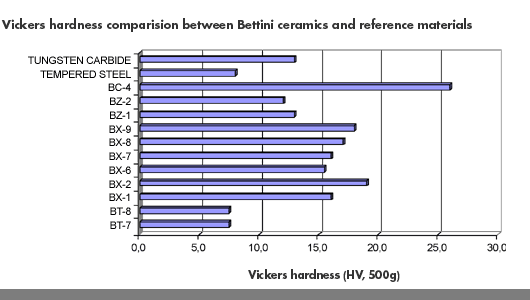 |
WEAR RESISTANCE
High processing speed, especially of synthetic fibres, mean that thread guides must be highly wear resistant.
The following table shows the predictable wear of thread guides based on the technical properties of the yarn and its processing conditions.
| Wear ratio |
Very low |
Low |
High |
Very high |
| Yarn |
Natural discontinuous
(e.g. cotton, wool) |
Synthetic discontinuous
(e.g. wool fibres) |
Natural hard
(e.g. linen, hemp, jute) |
Natural and synthetic continue
(e.g. silk, PA, PP, PET ecc.) |
| Yarn count |
Extra large |
Large |
Thin |
Extra thin |
| Yarn speed |
Low |
Moderate |
Fast |
Very fast |
| Tension and / or pressure yarn on thread guide |
Very low |
Low |
Moderate high |
Very high |
| Yarn spin finish |
Without finish or not wear |
Moderately wearing |
Wearing |
Very wearing |
| Yarn / thread guide contact length |
Long |
Medium |
Short |
Very short |
| Suitable materials |
Hard chromium-plated or thermal treated metal |
PO oppure BT-7 |
BT-8 Allumina BX-7 |
BX-8 BX-8 BX-9 BX-2
BZ-1 BZ-2 BN-1 BC-4 |
A ceramic material wear resistance depends on:
- hardness;
- specific weight;
- mechanical strength.
A great hardness is the most important conditions to obtain wear resistant parts.
The following figure compares 500g load Vickers hardness values of Bettini ceramics with conventional materials such as tempered steel and tungsten carbide.
 |
|
|
| BC-4 |
Silicon carbide |
| BZ-2 |
Zirconium oxide stabilised MgO |
| BZ-1 |
Zirconium oxide stabilised Y2O3 |
| BX-9 |
Aluminium oxide 99.7% |
| BX-8 |
Aluminium oxide 99.0% |
| BX-7 |
Aluminium oxide 97.5% |
| BX-6 |
Aluminium oxide 96.0% |
| BX-2 |
Aluminium oxide 99.9% |
| BX-1 |
Aluminium oxide - Zirconium oxide |
| BT-8 |
Titanium trioxide Ti2O3 |
| BT-7 |
Titanium dioxide TiO2 |
| |
|
 |
|
|
| BN-1 |
Silicon nitride |
| BC-4 |
Silicon carbide |
| BZ-2 |
Zirconium oxide stabilised MgO |
| BZ-1 |
Zirconium oxide stabilised Y2O3 |
| BX-9 |
Aluminium oxide 99.7% |
| BX-8 |
Aluminium oxide 99.0% |
| BX-7 |
Aluminium oxide 97.5% |
| BX-6 |
Aluminium oxide 96.0% |
| BX-2 |
Aluminium oxide 99.9% |
| BX-1 |
Aluminium oxide - Zirconium oxide |
| BT-8 |
Titanium trioxide Ti2O3 |
| BT-7 |
Titanium dioxide TiO2 |
| |
|
|
 |









